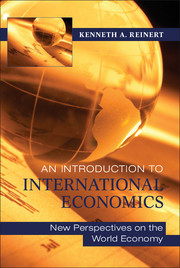Book contents
- Frontmatter
- Summary Contents
- Detailed Contents
- Preface
- Acknowledgments
- Acronyms
- Symbols
- 1 Windows on the World Economy
- I International Trade
- II International Production
- III International Finance
- IV International Development
- 20 Development Concepts
- 21 Growth and Development
- 22 International Production and Development
- 23 The World Bank
- 24 Structural Change and Adjustment
- Glossary
- Index
- References
24 - Structural Change and Adjustment
from IV - International Development
- Frontmatter
- Summary Contents
- Detailed Contents
- Preface
- Acknowledgments
- Acronyms
- Symbols
- 1 Windows on the World Economy
- I International Trade
- II International Production
- III International Finance
- IV International Development
- 20 Development Concepts
- 21 Growth and Development
- 22 International Production and Development
- 23 The World Bank
- 24 Structural Change and Adjustment
- Glossary
- Index
- References
Summary
Let's recall a few things you learned in some previous chapters of this book. In Chap-ter 16, you learned that, in a fixed exchange rate regime, an overvalued domestic currency (Mexican peso or Ghanaian cedi) is associated with an excess demand for foreign currency (U.S. dollar or EU euro). This excess demand for foreign currency is often met by the central bank drawing down its foreign reserves. The drawing down process is not sustainable, however, and can result in a balance of payments crisis. In Chapter 17, you learned that, in most circumstances, the International Monetary Fund (IMF) stands ready to assist member countries in dealing with such balance of payments crises considered in Chapter 18. If this assistance involves the member country's moving into its upper credit tranches (which it almost always does), the IMF imposes policy conditionality on its loans. In Chapter 23, you learned that, beginning in the 1980s, the World Bank began structural adjustment lending (later called development policy lending) to countries facing balance of payments difficulties, also imposing policy conditionality in the process. You were introduced to the case of Ghana in that chapter.
As you have seen, then, for developing countries with balance of payments crises caused by fixed exchange rates or changes in global economic conditions, structural adjustment under the supervision of the IMF and World Bank is, for better or worse, often an inescapable reality. The effectiveness of these structural adjustment programs has been the source of a significant amount of disagreement among international economists. It is now time to tie the discussion of Chapters 16, 17, 18, and 23 together in a close examination of the structural adjustment process.
Information
- Type
- Chapter
- Information
- An Introduction to International EconomicsNew Perspectives on the World Economy, pp. 435 - 454Publisher: Cambridge University PressPrint publication year: 2011
